Aug. 7 (UPI) — A St. Louis-area grocery store on Monday introduced customers to a new employee who doesn’t take bathroom breaks or need to call in sick — Tally the robot.
The Schnucks Markets grocery store in Richmond Height, Mo., was the first of three locations expected to test the new technology in the coming weeks. If all goes well, Tally the robot could be showing up in supermarkets across the country.
Tally, which is made by Sime Robotics, is a slim, black-and-white autonomous robot that moves around the store similar to a Roomba vacuum. Its task is to scan shelves to check prices, and alert employees if products need to be restocked or are incorrectly placed.







